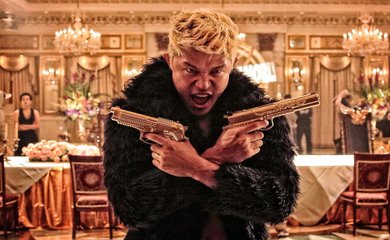Remember when movies were movies? Remember when voice–overs were the words of god on celluloid, balls out and bombastic? Remember Cannon Films? “Cannon Films the home of high power, high voltage motion picture entertainment!” Originally a small company turning out low budget schlock features like “Blood on Satan’s Claw” and overdubbing Swedish skin flicks and releasing them as art-house pictures, Cannon was sold to Israeli cousins Menahem Golan and Yoram Globus in 1979. They took an outraged Hollywood by storm, releasing a string of low budget dross that quenched the insatiable thirst of the VHS market in the 80s and were the prototypes for Miramax and the Weinstein brothers.
“Electric Boogaloo: The Wild, Untold Story of Cannon Films” by Mark Hatley is a breathless, hilarious documentary charting the rise and fall of the so called “Go-Go Boys” as they remodelled the movie business by preselling movies to foreign markets. Often Menahem and Yoram only had the poster ready to show potential buyers but that didn’t stop the “Bad News Jews” who had an “uncanny ability to make shit up” on the spot from taking the money and running with their crazy ideas. You want possessed aerobic instructors? Try “Ninja III: The Domination.” How about space vampires invading London? You need “Lifeforce.” What about Chuck Norris saving America from an army of terrorists? That would be “Invasion USA.”
Like in Hatley’s excellent documentary, “Not Quite Hollywood: The Wild, Untold Story of Ozploitation!” the various talking heads recall their outlandish stories with such wild abandon that we’re often left laughing hysterically at the sheer audacity of the Cannon head honchos. Just listen to the account of Menahem pitching a movie directly to the orang-utan who played Clyde in those Clint Eastwood films and try to keep a straight face! Occasionally they tapped into the zeitgeist of American culture and produced a bona fide hit like “Breakin” or make a film with a legend like Franco Zeffirelli who held the cousins in very high regard. Sadly, more often than not their movies sucked and the wheels came off their bus spectacularly after flops like “Masters of the Universe” and the disastrous “Superman IV: The Quest for Peace” but Hatley’s documentary is anything but.
Sion Sono’s latest outing “Tokyo Tribe” is a bizarre cut n shut mix tape, a hip-hop extravaganza played out over multiple decks like a Grandmaster Flash master class. And it defiantly doesn’t suck. Imagine “Trapped in the Closet” remixed by Baz Luhrmann sampling everything from “A Clockwork Orange” to “Escape from New York” and you’re just about there. Based upon the hit manga strip of the same name with dialogue rapped throughout, “Tokyo Tribe” follows the fortunes of the many competing yakuza gangs in and around the Bukuro district. The gangs are overseen by the cannibalistic Lord Buppa, an end level boss straight out of an 80s arcade game (or how about out of a Cannon movie?) who bides his time until he can unleash his secret weapon, the Waru horde and annihilate all of his rivals.
The key to any rap track, let alone a rap opera, is the rapping itself. If the lyrics or delivery are wack then we’re in danger of tuning out and turning off completely. With so many Japanese rappers (some pros, some not) on screen the quality varies from the sublime like Erika, “From the Wong Hong area” and the Gira Gira Girls, to the ridiculous in the form of The Nerimuthafuckaz, an amalgamation of Goldie Lookin’ Chain and N.W.A. after Ice Cube left to go solo. The humour is base, often obscene, the tone is brazenly uneven and the action brutal but what other director could pull off something so audacious? Thank the rapping gods that Sion Sono has the soul of a knife wielding maniac that’s so desperately needed to keep the whole damn crazy mess from blowing up in his face.
Equally audacious, but filmed in a controlled, austere manner more in line with Haneke or Kubrick is the Latvian slasher film “The Man In The Orange Jacket.” Sophomore writer/director Aik Karapetian has fashioned a lean, mean killing machine clocking in at a fraction over 70 minutes that still manages to lace the blood and gore with a strong smattering of social commentary. A rich industrialist leaving hundreds of families penniless closes down a harbour but one of the workers isn’t going to take it lying down. We track him stalking across the manual landscape, his orange jacket a blister against the granite skies. He could be a golem of legend created to reap vengeance upon the wealthy, which he does with the bloody efficiency of a skilled craftsman.
The worker takes up residency within the industrialist’s grand mansion. Here Karapetian’s film changes tone becoming instead a character piece examining the corrupting influence of money upon the working class and the burden of guilt that grows cancerous like a Banquo sized tumour. The grand interiors, double doors that open up onto more halls and rooms begin to work their dark magic similar in nature to Hill House in “The Haunting” and The Overlook Hotel in “The Shining.” The worker is clearly unstable but by just how much is open to interpretation. Is he dreaming or is there someone else at large in the mansion? Criticism could be levelled at the stereotypical working class traits Karapetian heaps on his killer (bad table manners and too much booze!) but overall “The Man In The Orange Jacket” is an effective age of austerity horror picture.

